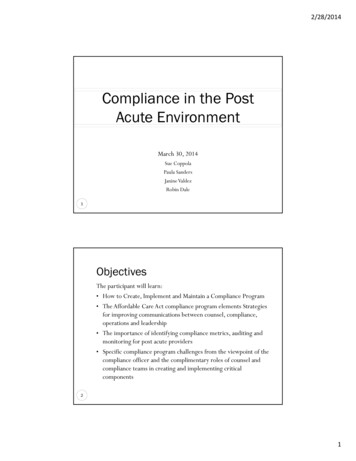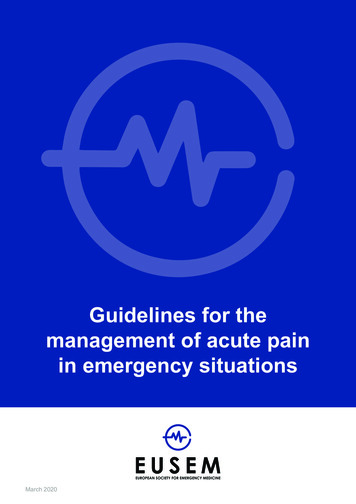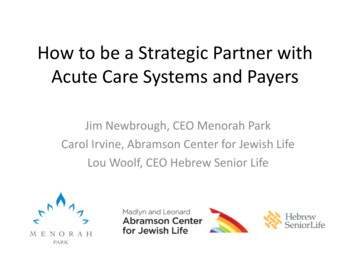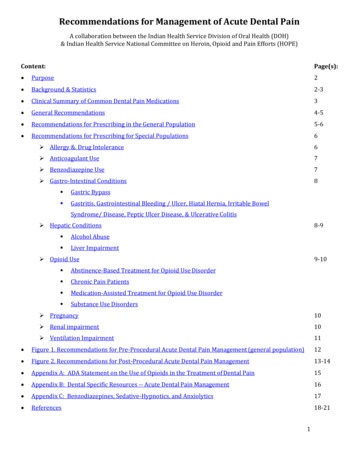
Transcription
2/28/2014Compliance in the PostAcute EnvironmentMarch 30, 2014Sue CoppolaPaula SandersJanine ValdezRobin Dale1ObjectivesThe participant will learn: How to Create, Implement and Maintain a Compliance Program The Affordable Care Act compliance program elements Strategiesfor improving communications between counsel, compliance,operations and leadership The importance of identifying compliance metrics, auditing andmonitoring for post acute providers Specific compliance program challenges from the viewpoint of thecompliance officer and the complimentary roles of counsel andcompliance teams in creating and implementing criticalcomponents21
2/28/2014Compliance Before the Affordable CareAct March 2000, the OIG published Compliance ProgramGuidance (CPG) for Nursing Facilities September 30, 2008, the OIG released the firstSupplemental Compliance Program Guidance for NursingFacilities3Compliance Before the Affordable CareAct Together, the two CPGs provided facilities with a roadmap tounderstanding the OIG’s expectations about what an effectivecompliance program looked like at that time. The OIG recognized compliance is not “one-size fits all”, butnecessary, regardless of structure. The OIG specifically suggests that long-term care providersother than skilled nursing facilities (“SNFs”), such as assisted livingproviders, should find the Supplemental CPG “useful.”42
2/28/2014ACA’s Impact Affordable Care Act (ACA), Sections 6102 and 64011. Requires compliance and ethics programs by March 3,20132. Statutory provisions are self-implementingCMS required to issue regulations thirty-six months afterpassage of ACA2. Regulations have not been issued but CMS will notenforce through survey and certification until rule inplace1.5ACA’s Impact The requirements echoes U.S. Sentencing Commission(USS) Guidelines: “Minimal” requirements of an effective complianceprogram is that the organization takes steps to: Ensure the organization’s compliance and ethics program isfollowed, including monitoring and audit to detectcriminal conduct;Evaluate periodically the effectiveness of the organization’scompliance and ethics program63
2/28/2014Is Compliance Really Mandatory? Programs must be effective at promoting quality of care Establishing minimum required statutory elements whichare based on OIG CPGs and USSC Guidelines States are now focused on Compliance Programs forMedicaid Provider7Is Compliance Really Mandatory? External Entities are inquiring about compliance and havetheir own compliance requirements IRS (Form 990) for exempt organizations Financial institutions including REITs Auditors Insurance brokers and companies for general and professionalliability Accrediting agencies: JC, CARF, CACC Medicare Advantage Provider Agreements84
2/28/2014Can We Predict Content of CMSRegulations? Medicare Managed Care Manual, Chapter 21 – ComplianceProgram Guidelines (2013). Prescription Drug Benefit Manual, Chapter 9 – ComplianceProgram Guidelines (2013).9Compliance Program Elements1. Code of Conduct/Written Policies and Procedures2. Compliance Officer and Compliance Committee Must be high level personnel of organization with sufficientresources and authority to assure compliance3. Sanction Screening OIG List of Excluded Entities and Individuals available athttp://oig.hhs.gov/exclusions/System for Award Management (SAM) available atwww.sam.govApplicable State Exclusions Databases4. Effective Education and Training105
2/28/2014Compliance Program Elements5. Internal Auditing and Monitoring and Effective Lines ofCommunication Use of a confidential Compliance Hotline is highlyrecommendedEmphasize prohibition of retaliation or intimidation of thosereporting noncompliance6. Enforcement System and Disciplinary Measures Include reporting requirementEmphasize that noncompliance can lead to disciplinary actionup to and including termination7. Effective Measure to Respond to Detected Noncompliance8. Periodic Reassessment of Compliance Program11Choosing Compliance Officer1. “High level person”2. Multiple roles in smaller organizations3. Relationship to General Counsel/Legal and Chief FinancialOfficer Government perceives conflict of interest for compliance tobe subordinate to or combined with legal or financeMost corporate integrity agreements prohibit subordinatedor combined roles126
2/28/2014Choosing Compliance OfficerOutsourcing4. Viable option for small organizations in some statesNew York requires an employment relationship Employee must be vested with responsibility for the day-to dayoperation of compliance programEmployee’s duties may solely relate to compliance or may becombined with other duties so long as compliance responsibilities aresatisfactorily carried outEmployee shall report directly to the entity’s chief executive or othersenior administrator and shall periodically report directly to thegoverning body on activities of compliance program13Choosing Compliance Officer5.Skills: Communication and Collaboration Understanding of organizations operations Objective and independent Ability to cross all business lines6.Consider the size of the organization and what reportingstructure provides the greatest ability to be independentand transparent Compliance transcends across the organization and individualmust have enough knowledge of each functional lines operationsto be effective147
2/28/2014Risk Assessments1. Establishes baseline2. Helps identify risk areas as well as complaint areas1.Monitor Internal operationsTrends, spikes, additional development requests (ADRs), claimsdenials, complaints Program for Evaluating Patterns: Payment Electronic Reports (PEPPER) Licensure and certification survey results Medicare Comparative Billing Reports (CBR) Quality indicators- falls, weight loss, pressure ulcers, return tohospitals 15Risk Assessments1. Monitor external sourcesOIG Work Plan, advisory opinions, fraud alerts Medicare Recovery Auditors (RAs), MedicaidIntegrity Contractors (MICs), Zone ProgramIntegrity Contractors (ZPICs), Payment Error RateMeasurement (PERM) Program, and ComprehensiveError Rate Testing (CERT) reports and settlements 168
2/28/2014Risk Assessments NY and other State Compliance Programs cover widerange of areas similar to OIG; Billing, payments, medical necessity and quality of care,governance, mandatory reporting credentialing,licensing, and other risk areas that are or should, withdue diligence be identified- loan covenants, HUDrequirements, resident refunds and other stateregulatory requirements Useful to create dashboards and annual work plans17Risk Assessments Often conducted by internal staff or external consultantsTo provide privilege conduct under direction of counsel Attorney may engage consultants to assist them in providing legaladvice to their clients, potentially extending attorney client privilegeand attorney work product protection No accountant “privilege”—communications and work papers arediscoverableo Accountants have a duty to disclose if they identify violations andare not satisfied by the company’s responseo “10A” obligation to report company misconduct internally andexternally if the company does not satisfactorily resolve the issueo If there are identified concerns on a compliance audit- a privilegedinvestigation may be initiated 189
2/28/2014Risk Assessments Compliance and Performance Improvement and QualityAssurance Committee should be synergistic Confidentiality and Transparency Inherent conflict Determine what needs to be protected, and from whom Be deliberative in deciding how and what to share Beware of e-mails and careless communications19Compliance Metrics20142010
2/28/2014Effective Measures for Each Element Creation of Dashboard Inclusion/coordination with other operational reporting Reporting StructureTransparency and Availability Review with Key Leadership Usage21 of DataBackground ScreeningPhysician ScreeningEducation/Training MetricsDisclosures DataMonitoring ScoresOverpayments and Other Corrective ActionsHIPAA Incidents and BreachesSample Dashboard2211
2/28/2014Sample Dashboard23Sample Dashboard2412
2/28/2014Compliance Program Outcomes Twobroad expectations Reduction of fraud Improvement in overall quality of care Results in: Cost savings to government andcenter/company Overall satisfaction with services25Quality Audit / Operational Audit SampleSelection Random vs. Risk-based Selection: Locations,Controls and Residents Independence/Objectivity Expertise Inter-rater Reliability Protocols and Tools Tests: Documentation/Observation/Interview2613
2/28/2014Quality Audit / Operational Audit Risk Assessment –What to Test? SNF Focus Areas – OIG Work Plan 2014 Medicare Part A REHAB Accuracy of the MDS Medicare Part B Services During Part A Stay Rehospitalization State Verification of Deficiency Corrections27Quality Audit / Operational Audit Phase VIII: Response and PreventionFollow up to Audit PerformanceImprovementValidation of Corrective Actions Validation of Effect of Corrective Actions Adjustment to Audit ProtocolsFeedbackDetermination of Effectiveness2814
2/28/2014RUGs Audit Regulatory Overview Review Process Selecting audit sampleMedical NecessityMDS ReviewRUG Calculation Common Areas of Concern Rehab Support ADLs Certifications and Orders29Compliance Officers’ Views Specific Compliance Challenges Being given the opportunity to be proactive, rather than30reactive Perceived reluctance of leadership team to includecompliance in strategic planning and initiatives Obtaining buy-in and respect- the forum to be pro-active andparticipatory Gaining knowledge about the day-to-day operations of theorganization Turf battles with “operations” and overlap with regulatory andrisk management – requires collaboration Difference between the need to “know” (monitor) and theneed to “act” (when plan is ineffective)15
2/28/2014Compliance Officers’ Views Specific Compliance Challenges Identifying metrics to monitor to be predictive Criteria for calling counsel Ability to conduct a complete and credible investigation Educating who do not know how to conduct investigationswhen it is not a core part of their job Dual/multiple roles of many compliance officers Maintaining objectivity, independence and sanity Criteria for counsel to engage Compliance assistance31ProgramImplementation ConsiderationsRole of Counsel Regulation Interpretation- Specific Issues, assistance with policy andprocedure language and review Updates regarding new or revised statutes and regulations Attorney/Client Privilege Compliance committee activity generally is not protected Having attorney attend every meeting does not extend attorney-clientprotection If issue is significant, consider calling counsel to assist and assess and directinvestigation to obtain privilege Assistance with interactions: OIG, Department of Justice (DOJ), Office ofCivil Rights (OCR), State or Federal Agencies, Recovery Audits Legality vs practicalityCommunicate and collaborate!3216
2/28/2014Role of Compliance Teams1. Implementation/oversight/risk analysis and revision of the2.3.4.5.compliance program----monitor effectiveness of programsand policiesIndependent investigationParticipating with counsel in reporting State/FederalagenciesReporting to management (highest level)Coordination of compliance committeeMonitor effectiveness, independence, communication, collaboration andeducation!33Strategies For Improving CommunicationsBetween Counsel, Compliance, Operationsand Leadership Education and re-education Staff turnover Complacency Non-punitive environment Mutual understanding of roles and transparency Can this matter be protected and how do we protect itAND did we educate all those involved Reporting structure Communication, collaboration, patience3417
2/28/2014Contact InformationSusan CoppolaSr. Vice President –ComplianceEmeritus Senior LivingSue.Coppola@emeritus.com(206) 378-3270Robin DaleWHCA President/CEO303 Cleveland Avenue SETumwater, WA 98501Office: 800-562-6170, ext. 101Paula G. Sanders, EsquirePrincipal & Chair, Health CarePractice GroupPost & Schell, PCpsanders@postschell.com717-612-6027Janine ValdezSenior Director of ComplianceGenesis HealthCare LLCJanine.Valdez@genesishcc.com(505) 468-23843518
Program Guidelines (2013). Prescription Drug Benefit Manual, Chapter 9 - Compliance Program Guidelines (2013). Compliance Program Elements 1. Code of Conduct/Written Policies and Procedures 2. Compliance Officer and Compliance Committee Must be high level personnel of organization with sufficient resources and authority to assure compliance 3.










